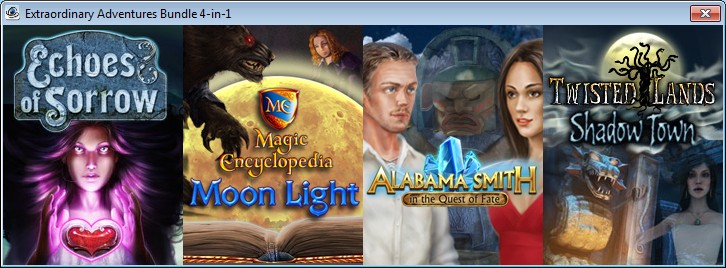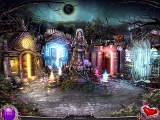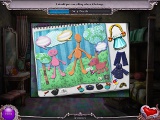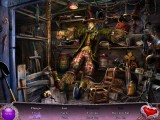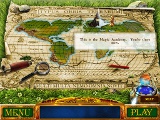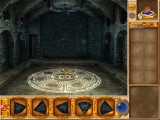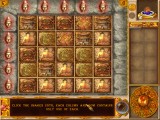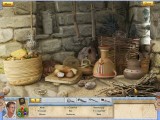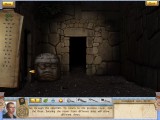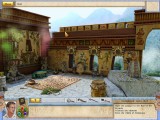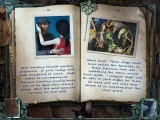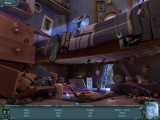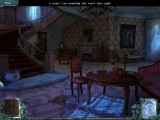





Hidden Objects Heroines Bundle 5-in-1:
Joan Jade and the Gates of Xitalba
Natalie Brooks: Secrets of treasure house
Alexandra Fortune: Mystery of the Lunar Archipelago
Mind's Eye: Secrets of the Forgotten
Amanda Rose: The Game of Time
A huge bundle of five, count'em, five hidden object games, I would absolutely recommend this as a gift for small children; the fourth game, my personal favourite, may be a bit grim, but the others are shiny colourful Teletubby fun. Yes, there are abductions and corrupt civil servants, but given the sunny settings, who cares? Four of the five games experiment with 3D modelling, although in the fourth game this is limited to a Towers of Hanoi game.
More pleasing to me personally is that this bundle, despite its size, doesn't conflict with any others - I hate it when two bundles contain the same game, taking up double disk space - and apart from the Natalie Brooks game, the games themselves don't appear to have any sequels (yet) that could end up in bundles and cause double installs in the future.

The first game is my least favourite, and also the only one that uses no 3D effects, relying on slightly garish painted scenes and "tuff" characters (check out the cowboy hat on Joan) having "dangerous" adventures to make up for a complete lack of fun and humour. Joan is basically an Indiana Jones clone, just like Alabama Smith below; she's even drawn in that pseudo-realistic, yet slightly stiff and awkward way. One half of an archaeologist couple, she is frustrated by the police's lack of efforts to find her children who disappeared while on a volunteer excavation trip, and decides to find them herself, communicating with her husband via cellphone, and keeping notes in her notebook.
The game starts with a jungle scene being lifted like a blanket accompanied by a "whoosh", and points out the only virtue of this game: its eye candy. There is no timer, and the game looks too old for voiceovers, although it does produce a "hmmm!" each time a clue or artifact is clicked on. There is a reaction to too many misclicks - a sound and the cursor shooting away - but it doesn't matter, as there are hardly any hidden object screens anyway! The main game is the truest graphical form of a text adventure yet: it's all about investigating the surroundings, and in the trophy room there are trophies for finding things like a number of artifacts in a row, although they are not needed to win the game. There are elaborate cursors for two situations the player can encounter: a gilded jigsaw piece for "solve puzzles" and a pair of decorated cowboy boots (talk about tacky!) for "go here". A newly discovered entrance is pointed at by a fat red arrow, and the puzzles, well, they're so simple that I don't feel flattered when a message pops up that, yowza, I won another trophy! The cut scenes are small screens, as prettily drawn as the rest of the game, and twice accompanied by a few bars of "Old and Wise" by the Alan Parson's Project (who, I suspect, don't know about this game) but only the last one is worth watching, as it shows why the police was so slow about finding the children.
The puzzles are: match tiles, match two fish tiles, solve riddles, pipe games, a match game with revolving wheels, more memory games, and some that are vaguely challenging: a labyrinth where Joan's route has to be planned out in advance, a board of squares where Joan has to find her way around traps and a box of rectangles that have to be moved around to free up the exit; and of course, in the main game, the finding of tools and how to apply them. Most of it is literally child's play, including the "instruction" button that re-shows Joan's latest "oh no!" moment, the two-headed snake bar that, once drained of colour, pops up a button that would let me skip the puzzle which, at that time, is almost solved, and the explanation, the first time I play under a given username, of what to do for each new kind of minigame I run into. This game allows multiple players but, fortunately, doesn't need that feature, because once [playername] has beaten the game, it just starts over - unlike some games where, to replay it, one has to create a new user - but without the explanations, so for each minigame I have to figure out or remember from last time what to do, which sort of makes it a memory game. It does have a self-recharging hint button, of which I don't know what it does since I haven't used it.
This adventure takes place in the Yucatan and, to complement the faux-Mayan visuals, has bright music with lively sound effects and happy birdsong. At least one bird (or bat, or rat) swoops or scurries past per location. Given how simple it is, I'm not surprised that it plays the same every time (there may be some variation with the fliptile games, but the search screens are always the same) so the only replay value is in filling up the trophy room. It's a good game to keep tiny tots occupied.
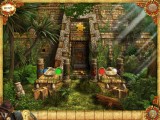
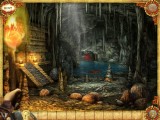
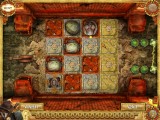
Natalie Brooks: Secrets of Treasure House, or just Natalie Brooks as it's called on CasualGames.com - therefore, I assume it's the first title in the series - has a number of sequels: Natalie Brooks: Mystery at Hillcrest High, which appears to have the same art style, Natalie Brooks: The Treasure of the Lost Kingdom, where the art looks more cartoonish, and Superior Save, dropping the main character's name from the title, in which the art is completely different. The art already starts out cartoonish in the first game: Natalie is a skinny post-teen in baggy pants whose postures and facial expressions are always contorted and exaggerated, in a world displayed in a slight fishbowl perspective to show how totally far out this game is, see? If the previous game in the bundle is suitable for tiny tots, this game is more for teens and tweens with a short attention span; the game is quite short, but enlivened by constant snide commentary, mostly from Natalie herself, to whom everything, to show her maturity, is either "yuck!" or "boring" - it's a good thing the game isn't voiced! Nevertheless, I like it. It alternates between cartoons and aforementioned fishbowl game screens in which the same character from the cartoon is rendered in animated 3D: see the second and third screenshot for an example. It also has a novel approach to hidden object searches.
To start with the story: Natalie returns to her old home, a mansion previously in possession of her recently deceased grandmother. The first thing she learns is that this magnificent building is about to be levelled to make way for a highway! The only way she can prevent this is by collecting signatures on a petition and finding the treasure hidden in the house to pay off granny's debts. The treasure is found soon enough, but the story doesn't quite end there, as she also has a bone to pick with the local police. As in the previous game, this is like a graphical version of a text adventure, where the player has to examine the surroundings, pick up any item that can be picked up, and use it to solve problems. Two additional things a player may find are fragments of a picture, about three to five per location, and question marks for hints, which I only saw in the lawyer's office during the tutorial and the smuggler's lair at the end of the game. Completing the picture is not necessary for winning, and I can't go back at the end of the game to find any pieces I've missed. Some items are obtained through winning a minigame, and the minigames here, as lively as the game itself - the switch-hitting game is like Whack-a-Mole - may require a steady mouse-hand and some reaction speed.
When starting, the game's opening screen shows an unobtrusive "are you player so-and-so? if not, click here" that is easy to miss. The game's tutorial is equally unobtrusive; it opens with a multi-panel comic that can later be rewatched by opening Natalie's notebook, going to the right chapter and choosing "View". Then, the elements of gameplay are introduced one by one. It is necessary to create a new player for every game, though, because clicking on "Start the game" (rather than the usual "Play" button) after completing it simply goes back to the game's last stage. The only reason not to delete the old player is for extra object searches, because unlike the self-recharging hint button that seems to be a staple of newer hidden object games, this game still has limited hints, in the form of coins (maximum five) that give hints which are actually useful, and when those coins run out, the only way to get more is to find question marks hidden in the game (which I suspect the makers forgot to put in) or find hidden objects. Although the main game, despite its initially easy-going but increasingly climactic background music, has no timer, the hidden object searches, with their outright relaxing music, are timed: 8 minutes to find 21 out of a possible 24 objects in three random locations that Natalie has already visited, and a hint as reward if you succeed. The objects change position each time a location is revisited, and though not cunningly hidden, are so jumbled that they may be surprisingly hard to find. Anyway, someone who just wants to seach hidden objects can restart the game, click away the coins and then click on the magnifying glass to start a new search.
Another reason to delete a player and start over is not being able to solve the game after a crash to desktop. This game is buggier than most, at least on my computer (is Windows 7 to blame?) and crashed three times in the same day, mostly recovering gracefully when restarting, but at one time trapping the player in one of the locations. What is not buggy but may seem so is that the game is very fussy about how the player clicks when and where; a basically correct action may result in a "this won't work" message because it was, for instance, done when Natalie's speech bubble was still open, or because an inventory object needed not one but two clicks to pick it up.
And while I'm complaining: this is again one of those games obviously not created by native English speakers, even though, as always, it is set in the USA. This manifests itself in tiny spelling mistakes, like the police tape reading "DO NOT CORRS THE LINE", but also vocabulary errors like using "detail" for component, "ruler" for protractor, "moneybox" for piggybank, and a really outrageous one, "airscrew" for propeller. Since they are played by children who are still learning language, maybe games like this should come with a warning: "May contain words that do not actually exist." Still, when the game is done and I'm treated to end credits showing the game team drawn in the same cartoonish style, I'm grinning and happy again.
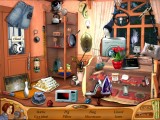
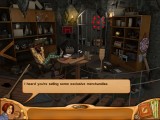
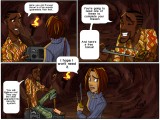
If you crave a holiday on a tropical island but don't have the
money, Alexandra Fortune: Mystery of the Lunar Archipelago is the game
for you. It will lead you past seven picturesque islands: Mahallii Island,
Mjollnir island, Chronos Island, Osiris Island, Babylon Island, Hermit Island
and Dragon Island, which show archaeological evidence of having been colonized
by Hawaii, Scandinavia, Ancient Greece, Ancient Egypt, Babylonia, Thailand
(would have been Siam, in those days) and Japan respectively - a claim even Thor
Heyerdahl would be sceptic about. These islands, forming the Lunar Archipelago,
may be tourist attractions, but the reason why bespectacled ("they're just
reading glasses") redhead Alexandra Fortune visits them is to find her
artifact-hunting grandfather, who does tend to run off on expeditions without
telling anyone, but who has been gone for suspiciously long this time.
After a well-integrated short tutorial, the player must find objects, or
fragments of objects, in scenes that are completely - including animated human
figures - rendered in milky 3D. This makes searching a bit tricky, as, while
these 3D objects can't be hidden as cleverly by recolouring them, and the search
bar at the bottom of the screen shows images rather than words (in fact, this
game could successfully be played by an illiterate person, although that would
mean missing the backstory), they may be positioned in a different way from the
example, and/or very small due to perspective, so I made frequent use of the
self-recharging hint button. There are two of these: a "where it is" button
producing a spinning cursor with a glowing green gem in the middle, and a "what
to do" button with a magnifying glass cursor that produces sparkles when moved
over a pertinent spot. Either will be greyed out when not applicable: for
instance, when one object/fragment remains to be found but is not in the screen
yet, and can only be unearthed using the objects already found and moved to the
inventory bar; and the sparkles will also spontaneously appear in an area where
an object has been successfully applied and which now needs clicking on, either
to move a bit of scenery or start a simple, yet skippable minigame.
The game believes in positive reinforcement; there is no timer or
sound/penalty for misclicks, but each find is rewarded with a harp chord. The
background music is topical, starting with hypnotic drumming during the
introduction that returns on the visit to the chieftain's hut (I have a special
savegame that stops here so I can listen to it while doing something else),
while what plays on Chronos island sounds like lyre music. Alexandra meets a
mysterious girl who claims to be the chieftain's daughter, a rich playboy whose
dream it is to find a pirate's treasure (and who at one time so gets on her
nerves with his pirate talk and over-the-top courtship that she slaps him
overboard) and, ultimately, her grandfather, who got himself trapped in one of
the many islands' temples that Alexandra explores (true, she should be searching
for gramps, but while she's there, why not indulge in her hobby?) in a sunny
story with a happy ending and the possibility of a sequel. Of course, the game
plays out the same way every time (for which I have to create a new player
profile, as a played-out profile will only replay the ending) but I enjoy it too
much to care. The only even vaguely annoying aspect of the game is the load
screen that pops up after every step of the way (even cut scenes!) is finished,
leading to a bird's-eye view of the island where Alexandra is with a
plastic-looking red arrow pointing to her location. I should press the glassy
green button labelled "Play", but of course I always instinctively click on the
arrow. In all, this would be my favourite game of the bundle - if not for the
next one.
Mind's Eye: Secrets of the Forgotten is my favourite game
in the bundle. Even though the game plays out the same every time. Even though
the inventory is a bit clunky; every time I find an item that is meant to be
used later, I'm switched from the to-find list to the leather briefcase. This
game is also not for little children, unless you want them to have nightmares.
The game itself starts with a nightmare. Although there doesn't seem to be
anything nightmarish about being in a lighthouse with a blizzard raging outside,
trying to find a way out.
Actually, the very beginning of the game is typewritten sheets of mixed
instructions and dialogue, flipped over like pages. Then comes a noticeboard
with various notes and pictures pinned to it; if I quit the game halfway through
and return to it later, this noticeboard shows the progress made. Then, the
introduction; looking for an excuse not to attend the Mnemosyne show, because he
thinks the three singers are creepy, the mayor of the city of Vernida is
confronted by Dr. Orpheus, who reassures him that this won't take long. Next,
the lighthouse scene, from which the heroine of the story awakens to find
herself at the office of the newspaper she works for. Her boss calls; she must
go to the mayor's house to cover the news of a suicide, the cameraman is already
there. Instructions follow on how to play the game, although the roll of camera
film hidden in each scene that will add an extra hint to the self-recharging
hint button was already there in the first two scenes. This roll of film can be
hard to find, especially in the lighthouse scenes. Each scene is slightly wider
than the screen and scrolls from right to left, changing the perspective and
bringing out objects that were hidden behind other objects; some items even have
to be "found" by scrolling the screen until two fragments fit neatly together.
The reporter doesn't believe this is a suicide, but is taken off the case and
sent to investigate a delirious girl who locked herself up in a subway station.
The girl, the reporter, the nutty scientist who helps them out and the mayor's
death are all connected to Dr. Orpheus and his experiments in the lighthouse.
The scientist has made a contraption allowing the reporter to enter people's
minds (my favourite: Molly and her dollhouse) where she discovers Orpheus's
helpers at work. Going back to the original lighthouse, she plays a Towers of
Hanoi game (the only instance of 3D in the game), discovers her past and defeats
her nemesis. What makes me play this game over and over; the creepy music, the
creepier settings and the deranged faces of the original Mnemosyne sisters.
Being an "investigating reporter" story, it features much typewriter clacking
and an inventory/list/dialogue box that is alternately a notebook or aged
parchment against a leather cover.
Amanda Rose: The Game of Time is completely in 3D except
for the comics between chapters, and another game ideally suited to children,
because it is both incredibly pretty and encouragingly simple. Of course Amanda
is another eye-candy heroine, but for eye-candy she barely compares to the
game's opening scene with a watch-like bit of clockwork surrounded by roses, the
candy-cane loading bar, the journal awash in rose petals and the intricate
designs appearing in puzzles like the three keys that have to be matched to
their locks, and the final scenes of the game itself. All the roses in the
visuals - even the game icon is a rose - refer, of course, to her surname and
that of her father, who finds himself in the same position as the father of
Bella Swan: having a sissy surname just so his daughter can sound as well as
look pretty. Nevertheless, the opening comic lets us know, Dylan Rose is a
respected lawyer and pilot (now that's an odd combination of careers) who is
called away on some expedition. A few days after his head-over-heels departure,
Amanda receives a letter and something that looks like a wristwatch: she must go
to Monument Valley in Arizona, find a cube near the remains of her father's
crashed aeroplane, take a stone from it and put that in the pseudo-wristwatch,
and follow the instructions to find her father. The game starts in said valley,
asking if the player wants a tutorial, but this tutorial adds very little to the
game and is only for people who have never played hidden object games before.
First, there is a list of items to be found. They will appear as greyscaled
objects in a bar at the bottom of the screen, the item descriptions appearing in
tooltips when the cursor hovers over them. The problem is that these are 3D
items, and so a vase that is shown standing upright in the item bar at the
bottom of the screen, may be lying on its side half out of sight in the main
screen. For every found item, a spacey synthesizer chord is sounded; misclicks
get no sound, although too many misclicks in a row make the cursor go belly-up
in a big arc. Okay, all the items have been found, and now new items appear,
fewer in number, with locks over them to signify that something has to be done
to unearth them. Now, when moved over the screen, the cursor will change into a
hand whenever it moves over a bit of background that can be moved, a magnifying
glass for a close-up, or gears for something that needs an object from the
inventory to act on it; if the wrong object is held over it, the gears are
struck out by a cross. Helpful, eh? For every object that needs something done
to it (like opening a locked chest) a task is added to the journal. When every
last object has been found, and possibly applied in some way, followed possibly
by a simple puzzle (although sometimes, as with the locomotive and the railroad
squares, it takes me some time to figure out what is expected), the bar that
normally holds items and their descriptions helpfully tells me in block capitals
that all objects in this room have been found. The game is divided into
chapters, each with its own name, and where the first chapter has just one
"room" (the crash site) with very few objects to find, subsequent chapters have
two or even three rooms, between which the player must move to collect all items
and solve all puzzles, and the object list becomes longer and longer. The
self-recharging hint button is also very helpful: it allows the player to either
select an item from the list or cancel, and if the item is not in the current
room, the hint button will both flash the arrow to the right room and indicate
the object in the room itself.
The story, related through letters from her father and his handyman companion
"Doc", and some very wooden dialogue, takes Amanda back a century in the Wild
West where she helps out a saloon owner, goes after bank robbers and winds up in
a teepee with the native American chief Bear Heart and his beloved dog Yokki
before finding an Atlantean temple, where the game designers really go overboard
with the decor. It is here that she receives a special lens to find invisible
items. All ends well for everyone except the villain - and the poor snake
guarding a key - after which the player can just start from the beginning of the
game again, without having to create a new profile. The background music playing
throughout this story sometimes has a hint of suspense, but is mostly wistful,
as if written for a sad romantic film. A funny detail: all characters including
Amanda are rendered in 3D just like the objects, and during dialogue, their
threedimensional head appears in a circle to the left of the text. This circle
usually contains Amanda's own head, blinking and smiling and moving around a
bit, and when - this is easy to miss - an object is found, the head may nod
approvingly.
Extraordinary Adventures Bundle 4-in-1:
I bought this bundle for the third Magic
Encyclopedia game, Moonlight. On starting the bundle, I was greeted
by the old Oberon Media screen, although the site had already migrated to
CasualGames.com. Is that why these gamesaver exclusive bundles were going cheap?
If so, Oberon's loss is my gain. However, the executable I downloaded for
installing was more hidden than usual; after a disk search I found it in
C:\ProgramData\Oberon Media\Initiator\3.0.0.0\cache\. This marked the beginning
of making it hard and even pointless to keep installation executables as
backups.
As opposed to the previous bundle, I would absolutely not
recommend this for children, excepting the Magic Encyclopedia game which is as
fluffy as the previous two. The fourth game is
another all-Russian work, and boy, do Russians like their games grim and gloomy.
After an intro where a woman is chased by a shadow, trips, and
is carried off unconscious, Echoes of Sorrow begins in a mysterious way,
with a whistling steam train outside a gate illuminated by two bowls of ghostly
blue fire. It soon becomes clear that this is one of those puzzle games that
include hidden object screens, rather than a pure hidden object game, as there
are many items to pick up or interact with. When, through solving a puzzle
involving clock hands from a hidden object screen, the gate is opened, the
player moves into a square containing, at its centre, a stone statue of a woman
hung with four coloured chains that lead to four flames of the same colour,
surrounded by four "gates" to different parts of the woman's life. Sad
background music plays, as each locale is investigated for clues that may help
recover the memories of this petrified woman. In each place there is a shadow to
banish, yielding one part of a ticket, and the gem from each place is placed in
the right flame, causing one of the chains to fall off. When all chains are
gone, resulting in total recall of various tragic events, and the ticket is
complete, it becomes possible to board the train that goes back to the real
world (a disappointment after the surreal main setting) and apprehend the
villain.
This woman clearly lived in the fifties and sixties, judging especially from
the "college" locale and bearded, guitar-playing boyfriend. As revisited in her
memories, all locations are old and ruined and covered in cobwebs. In contrast,
the magnifying glass, hand and walking feet cursors, and revolving gears for
interactive objects, are Windows XP (as a colleague once called it, "Windows for
Teletubbies") style, lilac and glassy. Gathering all items needed for the
journey back home requires travelling between locations ; an item needed to
chase off the shadow in location 1 is found in location 4. When in need of an
item to move the story forward, it's a good idea to revisit previous search
screen locations to see if there is a new hidden object screen, signalled by
shimmering stars, and the surest way of knowing that one location is completely
finished with is when it changes into a search screen itself. Hints are
dispensed by a self-recharging "bleeding heart" hint button, and there are no
sounds or penalties for misclicks, although a dramatic "whoosh" is played for
every object found. In a tragic game like this, it is fortunate that timers and
voiceovers are absent, as they would have ruined the atmosphere. The game
finishes quite abruptly and after that, I have to create a new player to play
the game again, else I just get the replay of the triumphant ending.
The husband-stalker is back in the sequel, Echoes
of Sorrow II.
The freckled child from Magic
Encyclopedia: First Story is back, although she retains the purple dress
from the second game. This time, her brother asks for help to find a missing
teacher. This is like the first game, but vastly improved; there is the same
globe-hopping and "exciting adventure" soundtrack, but the cut scenes, instead
of being ugly pencil drawings, are beautifully painted, the dialogue is less
stilted and even the world map screen looks more polished. The only naff feature
of this game is the empty white screen with one message telling the player to
"Click Next", each time a new location appears on the map.
The tutorial has been seamlessly integrated into the game by way of the
flying paper crane that Catherine's brother Roger used to send her a message,
taking the player on a tour of the features and showing how to assemble the
first item from its hidden fragments. The visuals are painted, the better to
disguise many, many fragments in a room that seems empty, not only in the main
screen but also in little popup screens in spots that change the cursor from a
golden arrowhead pointer to an eye when they are hovered over; other cursor
changes are a hammer for interaction (brutal!), a hand for picking up and
walking feet for an exit. Once assembled, each item becomes a tool for finding
part of the next item; if this takes a while, one of the places to apply an item
starts to sparkle, and moving the cursor over it provides a helpful comment. The
second inventory to the right of the screen, where fully assembled items go, is
the "wolf artifact", as if it wasn't clear enough yet from the title and howling
in the opening sequence that the subject this time is werewolves.
This game works the way I like it: no timers, no voiceovers and a
self-recharging hint button. There is no penalty or even sound for misclicks,
which is only fair as sometimes I really can't tell the fragments from the
background - the hint button has been frequently used - and although it might be
that I didn't search thoroughly the first time, I swear that more fragments are
added as each little puzzle is solved; I often think: "Hey, that wasn't there
before." The locations are literally all over the map: Buddhist temple, Pacific
island village, Minoan labyrinth, and the magician's house where Catherine has
to detransmogrify her brother who was turned into a rabbit (Roger Rabbit, heh)
before she returns to the cave where she battled the dragons in the first game's
ending. For this ending, she needs an artifact inlaid with many gems; I have to
find about two gems in every search screen, and if I don't have them all before
the final showdown, the paper crane warns me, and on the map I will see all
locations that have undiscovered gems.
Among the puzzles that must be solved to discover each next item are literal,
minigame puzzles, often using tiles, sometimes in the way of a 2D Rubik's cube
(keep flipping until all tiles show the same image). They were fairly easy
except two, where objects have to be fitten inside a labyrinth-like shape built
up of squares "without touching anything". I found out through trial and error
that this means "with always one empty square between two objects", and that the
objects can be rotated from horizontal to vertical. Once I realized that, they
were a breeze. Once the main game is finished, choosing "Play" for that
particular player name will simply replay the ending, but to make it worthwhile
all the same, the player can now access and replay all the minigames.
The first thing that strikes me about the main character of
Alabama Smith in the Quest of Fate is the cultivated facial stubble.
Apparently, being perpetually unshaven not only during field trips, but also in
the office, is some sort of manly beauty ideal. And it is in the office that the
game starts, after a brief puzzling intro about the Knights of the Illuminati
who protect humans against the secrets they can't handle. Apparently the Russian
game company was unaware that the Illuminati are not popular with Western
conspiracy theorists. Anyway, our pseudo-rugged hero is in the office - at Yale
University, no less - when he gets an email from his employer, Dean Sanders: the
Inca figurines they have been studying are to be crated and returned to Peru.
This task acts as a tutorial, letting the player run between the office, lab,
storage room and corridor to carry out requests. A mysterious fire in the office
brings up the subject of the Crystals of Fortune in Machu Picchu, so Alabama
Smith, taking a colleague with him, goes there to investigate. Finding the site
vandalized, he calls over Anastasia, his friend and love interest from Italy, to
bring him the amulet that will let him travel to the past, when what he is
looking for was still intact; he asks his colleague, Wints, to please keep this
a secret. They discover something that is emailed back to Dean Sanders, and the
game journal that recorded the tasks and discoveries of Alabama Smith now serves
Dean Sanders, back at the university rooms, but now with intermittent browning
(apparently the stormy weather is causing power outages) to make the searches a
bit harder. Sanders emails back his discoveries, and now it's Wints that's
followed by the journal, taking the amulet to do some secret research of his own
and negotiating a maze along the way. Triumphant, Wints reports to Smith and
together they try to activate the Crystals of Fortune, which leads to a showdown
between the two and the former's death, followed by the game stating that you
can save him if you find out all about what happened to his wife Mary.
With the plot out of the way (and there's nothing in the spoilers that you
won't see coming in the game, including Wints going rogue), now something about
the game itself. I've already mentioned in that game's review that Joan Jade
from Joan Jade and the Gates of Xitalba is much like
Alabama Smith; they're both Indiana Jones wannabes, drawn in the same slightly
stiff style, with accessories that make them look "tough"; in Smith's case, the
ridiculous first name and the baby beard. Fortunately, this doesn't carry over
into the way he acts - he's just a dedicated archaeologist with a crush on his
lady friend - and it must be said that the art in this game, both the cut scenes
and the search screens, is superior. This game itself is also more advanced than
the other one, in that it is much harder. In fact, it has two levels, Casual and
Expert, between which the player can switch at any point during the game. In
Casual mode, puzzles can be skipped, and there is a bar at the top of the screen
to let the player know, for each room entered, what objects to find in that
room; this doesn't always work, nor does the self-recharging hint button give
the information needed: I had to look up a walkthrough to find that the
replacement for the broken green crystal is Smith's magnifying glass. In Expert
mode, puzzles can't be skipped and the hint button takes more time to recharge,
but I seem to have much more hints (maybe I get a hint for each set of "talking
knots" I find?) and there are more items in each room, that are not in any task
or to-find list, but will help gain points in the Trophy room; in fact, it's a
good idea to visit the Trophy room before the start of the game to get an idea
of what extra items can be found. Otherwise, it's just a matter of clicking on
everything you see, since misclicks don't seem to have a penalty. There is no
timer, but of course some of the trophies are for completing a task within a
given amount of time.
The whole game is a puzzle, really; genuine search screens are rare. The
screen layout has a big bar along the bottom, and a narrow one at the top in
Casual mode. The big bar is divided up into a small set of inventory buttons,
containing mostly Smith's basic set of tools that he collects before setting
off, a space under it that is used for the item list in search screens, and a
box to the right that lists tasks. Normally, the player just has to carry out
these tasks, whether it's "find 12 figurines" or "open the sarcophagus". Many
objects have descriptions that show up when the mouse moves over them, and are
simply there to amuse or provide background information, like Smith's photo
album. An item that is unclickable at one point of the game, like the spade at
Machu Picchu, may become clickable once the task it is needed for has been added
to the task box, which is why the top bar in Casual mode is useful; and this bar
doesn't always report what it should; for instance, it stays empty when a key
that needs to be found is hidden in a vase. Again, the motto is: click on
everything you see! The real search screens that sometimes pop up, starting with
the lab's cabinet, are so difficult, with so many objects crammed into them and
hidden so well, that it's just unfair. The puzzle screens are doable, and in
fact easy compared to the general puzzle of knowing where to find what item at
which place in what time - there is an awful lot of time travel - besides which,
solutions to them can generally be found in the journal. The whole
headache-inducing (at least when played for the first time) game experience is
lightened up with happy background music, and should the player wish to start
again or replay a scene in Expert mode for maximum points: the game has an index
of chapters where you can choose a chapter to replay, although all progress
beyond that chapter will be lost.
This game is a sequel to Alabama Smith: Escape from Pompeii, where
Smith, in his clean-shaven student days, finds his time-travelling amulet.
Upholding the idea that manly good looks require a five o'clock
shadow, the main character of Twisted Lands: Shadow Town proudly sports
stubble under his baseball cap. The introduction shows him in a motorboat with
an example of womanly good looks, two dead-eyed mannequins together. He is lucky
enough that his female associate and private crush has gone boating with him to
watch him do his diving thing, although she chiefly sits there being pretty and
reading a magazine. For the record, she states that stealing artifacts is a
crime, although it's implied she'll be helping him sell them. Our heroes, the
artifact thieves. I hate them already.
He shows his catch for the day, a carving of a rearing serpent folded up like
a harmonica. The next thing he knows, he's violently knocked overboard, his
motorboat lies wrecked on the shore he's stranded on and his crush is gone. The
island he washed up on was evidently inhabited some time ago, judging from the
clues he gathers about the terrible things that happened there, and the same
plague has afflicted the passengers of the cruise liner shipwrecked nearby.
According to a game text file there should be a bonus chapter about the island
inhabitants, although they don't appear in the game itself; apparently this
bonus chapter would be available if I'd bought the game on its own, rather than
as part of a bundle. And may I add that the text file drives home what the
in-game text suggested: that the makers are not native English speakers. Judging
from the credits, they're Russian. The story itself plays out on a deserted
Spanish island. Anyway, Stubbleface saves his girl from evil cultists and
escapes the fate of the islanders... or does he? I don't care how badly it ends,
because I hate him.
The main menu offers Options, including Easy Mode "with sparkles"; Video,
which opens a book of scenes to replay, the text descriptions besides them
including sentences like "What have happened?" (note: all game text is in
"properties/strings.xml", so perfectionists can have a field day correcting it);
Play, which, if I've just finished the game, starts over again with the intro,
and at the top of the screen, Change player. The background music is a cheerful
clarinet at first, but will soon reach Hitchcock levels of scary, with hissing
voices and an ominous choir around the cultist's cave. The collapsible inventory
bar that becomes a to-find list in search screens has a self-recharging hint
button to the far right in the form of a mirror with a question mark in it; if
clicked, it shatters and the shards form a circle around the item to find or act
on or, if the player isn't in the right room, on the arrow that will lead to
that room. Indicating an arrow doesn't use up a hint, and is a good way to save
time, as most of the game is running around to apply item X found in scene Y to
scene Z, or looking for search screens to hopefully turn up that key needed for
that chest (only to find out it must be opened by a crowbar...) To the far left
is a journal storing snapshots of maps and codes that are later needed
elsewhere. Areas that can lead to search screens will sparkle if there is
something to find; in easy mode, anything that needs something done to it will
sparkle if the cursor moves over it, including objects that have to be moved to
discover something under it. When not playing in Easy mode, this sort of thing
is up to the player to discover, and the motto, as in the previous game, is
"click on anything you see". except in actual search screens, where one misclick
is ignored, but clicking too often is punished by approaching mist and hissing.
The search screens are nicely done, the items to find being disguised by their
colours or by being a shadow or drawing, as I'm used to in hidden object games
where the focus is on finding objects. Most areas to search are bathed in
bluish-brown light, and sometimes covered with thin fog to make the searching
harder; the whole island is covered in fog, and should have been called Fog Town
rather than Shadow Town. There are puzzles, mostly about moving tiles around,
which are skippable, and no timer anywhere, so I can keep the game running as
musical accompaniment while I'm doing the dishes. One thing I did discover on
replaying it is that the search screens are exactly the same each time, which is
easy to overlook in a game that has me running between locations so much. The
ending is not only gloomy but strange, as if it had something added to it after
the game was programmed; you'd think the main character would notice if he had a
knife wound. Instead, he divides his attention between gushing over his beloved
Angel (yes, that's what she's called) and looking for stuff to loot. It would be
a sad ending if he didn't come to grief.
There are two other titles in the Twisted Lands series: the prequel
Twisted Lands: Origin and the sequel Twisted Lands: Insomniac (the
latter combined with this game in the Twisted Lands 2-in-1 Bundle), but
if their protagonists are as unsympathic as this one...
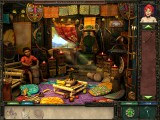
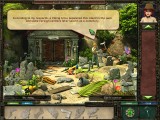
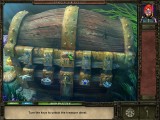
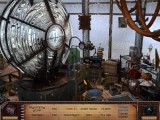
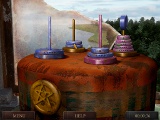
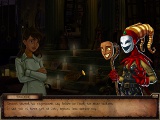
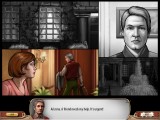
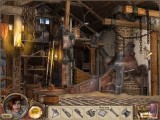
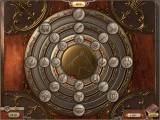
Echoes of Sorrow
Magic Encyclopedia: Moonlight
Alabama Smith in the Quest of Fate
Twisted Lands: Shadow Town
